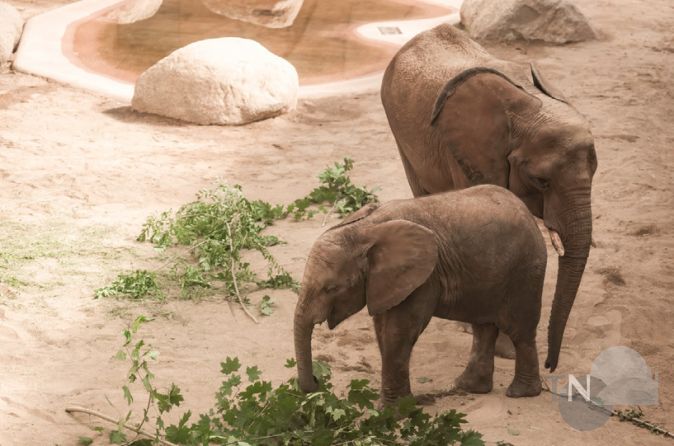Königstein/Kronberg (kw) – The elephant herd at the Opel Zoo in Kronberg has grown by two specimens: The elephant cow Cristina and her two-year-old son Neco came from the Cabárceno Nature and Animal Park in Spain.
The elephant herd in the outdoor enclosure is now consisting of the following five animals: Tamo, male, born on 13 January 2008 at Wuppertal Zoo, at Opel Zoo since 17 April 2013; Lilak, female, born around 1971, wild caught, 30 May 1974 to 17 April 1996 Berlin Zoo, then Tierpark Berlin, at Opel Zoo since 26 August 2020; Kariba, female, born on 17 March 2006 at Tierpark Berlin, at the Opel Zoo since August 26, 2020; and Cristina, female, born on June 18, 2006 in the Cabárceno Nature and Animal Park; and her offspring Neco, born on January 8, 2021.
The arrival of the new pachyderms was preceded by elaborate preparations. With targeted training, the animals were prepared for transport over a period of months. The two made their way from the north of Spain – Cabárceno is about 50 kilometres west of Bilbao – in special air-conditioned containers with built-in water tanks and camera surveillance. In addition, the head elephant keeper and the responsible scientific curator came to the Taunus for a few days to accompany the two as trusted persons upon their arrival. A heavy-duty crane lifted the containers one after the other in front of the gate of the elephant house, into which the two animals were then carefully guided by the keepers. There they have now moved into their new boxes and are now getting used to their new environment and the new herd.
The two newcomers begin their settling-in phase behind the scenes in the elephant house. Depending on the course of events, they will probably be shown to zoo visitors for the first time in the running hall of the elephant house before they get to know the outdoor area. They will by then have got to know a little the other three Kronberg elephants: In the stables, the animals can smell each other and make their first visual or even trunk contact. In addition, elephants communicate with deep infrasound, which is inaudible to humans.
According to the press release, with the admission of the two elephants from Spain, the Opel Zoo is taking another step closer to its goal of re-establishing a breeding facility in Kronberg for African elephants classified as endangered. The facility of the outdoor enclosure is designed for a bull with four cows capable of breeding and offers enough space for the rearing of their young animals, explained zoo director Dr. Thomas Kauffels and adds: „With Kariba and Cristina, there are now two cows in the Opel Zoo that are ‚suitable‘ for Tamo.“ So, the conditions have been created and now those responsible for the zoo are eagerly awaiting further developments. To put it bluntly, those responsible for the zoo are waiting for offspring. After all, there has just been the news that there had been elephant offspring in a West German zoo. So why not also in Kronberg?
About the elephants:
Elephants are among the most impressive animals that nature has produced and today the heaviest terrestrial animals.
In evolution, large forms have emerged again and again, because the danger of being eaten becomes less and less with increasing strength. But huge ‚modifications‘ are necessary for an organism weighing tons to still function. Elephants have pillar legs to carry the huge weight and are only capable of walking and trotting, but no longer of galloping. Elephants have a gigantic head with the heaviest brain of all mammals. It weighs about 5,000 grams, making it even slightly heavier than that of the blue whale (for comparison: human brain about 1,600 grams). Despite its lightweight construction with air chambers, the skull has become so heavy that an elephant can only wear it on a short neck.
The trunk
But how does the elephant with its short neck get to the grass growing on the ground? Rather not at all and for this reason an auxiliary organ had to be found to procure food, the trunk. It originated from the adhesion of upper lip and nose and has become the most important tool of elephants. From the original functions of a nose (smelling, breathing) to nutrition and personal hygiene to a strike weapon, everything is part of the tasks of a trunk.
Lack of fur
Another of the many peculiarities is the lack of fur. The larger a body is, the smaller its relative surface area and the less it loses heat. Elephants are so big that their problem is not that they freeze, but that they can no longer release enough heat into the environment. A fur insulates in both directions, it keeps the cold out and the heat in. If an elephant of the hot African savannah had a lot of hair, it would die of overheating. The African elephant‘s large ears also help to regulate temperature, with excess body heat being emitted over their huge surface.
If there is a disadvantage to size at all, it is because of the amounts of energy that such a large organism devours. Elephants are pure vegetarians, but once again in gigantic masses. Elephants are poor feeders and do not even use 50 percent of the nutrients they contain. Therefore, they need to eat up to 200 kg per day and drink about 100 litres of water. At times, elephants are busy foraging and feeding for up to 18 hours a day. (Source: Opel Zoo)

